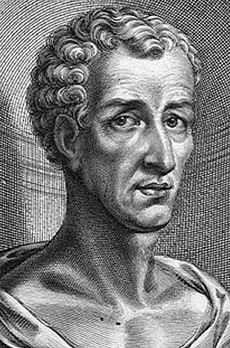MARIANO TOMATISWONDER INJECTORItalian writer and magician
|
 Magic & Ancient Greek LiteratureAlexander and his magic tricks in the 2nd century Posted on thursday 19 june 2014, 50 days before scifoo14 • Written by Mariano TomatisToday 450,000 Italian students of secondary school have attended their examination to get the diploma of maturità: it will grant them the right to attend university. Students from Classical Lyceum must demonstrate their learning in Greek with a written test that consists of a text to be translated into Italian. Being a centralised test, it is the same for all the institutes. Today the choice has fallen on a text written by the supreme Ancient Greek satirist: Lucian of Samosata (120-200).  From a magician’s point of view, his most interesting work is The False Prophet, the true story of the most notorious imposter of the second century of the Christian era: Alexander of Abonoteichus. The man claimed he was in contact with a manifestation of the god Asclepius, in the form of a snake he called Glycon. Lucian describes the darkened room where his followers could meet a snake with a human head, talking to the attenders. Alexander created it by putting on a real reptile a human-like dummy head: [he] had given it a more or less human expression, and painted it very like the real article; by a contrivance of horsehair, the mouth could be opened and shut, and a forked black serpent tongue protruded, working on the same system. (1) The prophet learned of the magical arts through a friend who was a professional magician, then he started to sell fraudulent medicines, learning that humans are driven by emotions which can be easily manipulated in order to get rich quickly. Lucian’s work is full of technicalities about trickery, being one of the earliest documentary sources about the use of rational techniques to create magical experiences. Sometimes the “gaffed” snake could speak through a tube of cranes’ windpipes, which he passed, with due regard to its matching, through its artificial head, and, having an assistant speaking into the end outside, whose voice issued through the linen Asclepius, thus answered questions. (2) Working like modern audio power amplifier, these oracles were called “autophones”. Alexander could also secretly read messages with a clever trick: Alexander proclaimed that […] the God would give answers to all comers. Each person was to write down his wish and the object of his curiosity, fasten the packet with thread, and seal it with wax, clay, or other such substance. He would receive these, and enter the holy place […]; he would learn the God’s mind upon each, and return the packets with their seals intact and the answers attached, the God being ready to give a definite answer to any question that might be put. […] The trick here was one which would be seen through easily enough […] He contrived various methods of undoing the seals, read the questions, answered them as seemed good, and then folded, sealed, and returned them, to the great astonishment of the recipients. (3) …19 centuries before NSA! _________________ (1) Lucian of Samosata, The False Prophet, chapter 12. (2) Lucian, c. 26. (3) Lucian, cc. 19-20. You could be interested also in:
|
 Science Foo Camp (or “Sci Foo”) is an invitation-only gathering organized by Digital Science, O'Reilly Media, and Google, with support from Nature. The 9th edition of Sci Foo takes place on 8-10 August 2014 at the Googleplex in Mountain View, CA. Lord Martin Rees has defined it as “a sort of mini Woodstock of the Mind”. Participants include researchers, writers, educators, artists, policy makers, investors, and other thought leaders, all doing groundbreaking work in diverse areas of science and technology.
Science Foo Camp (or “Sci Foo”) is an invitation-only gathering organized by Digital Science, O'Reilly Media, and Google, with support from Nature. The 9th edition of Sci Foo takes place on 8-10 August 2014 at the Googleplex in Mountain View, CA. Lord Martin Rees has defined it as “a sort of mini Woodstock of the Mind”. Participants include researchers, writers, educators, artists, policy makers, investors, and other thought leaders, all doing groundbreaking work in diverse areas of science and technology.